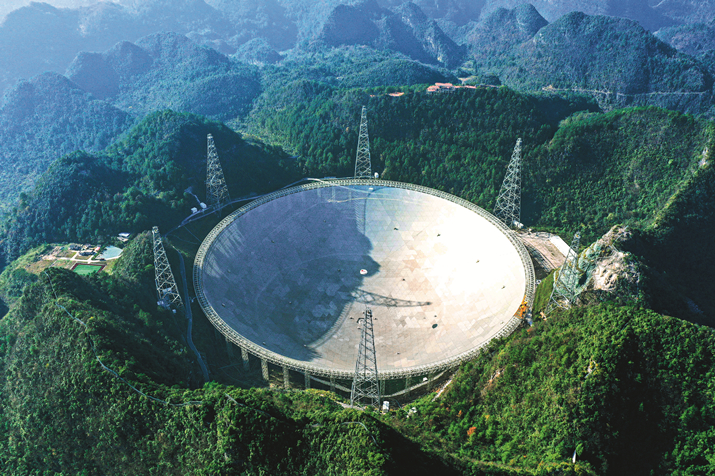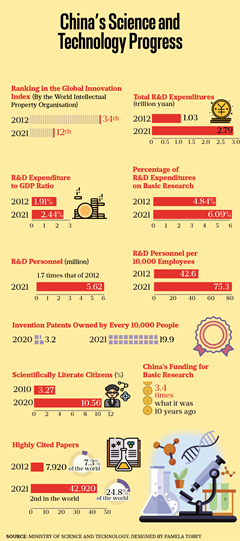|
||||||||||
| Home Nation World Business Opinion Lifestyle ChinAfrica Multimedia Columnists Documents Special Reports |
|
||||||||||
| Home Nation World Business Opinion Lifestyle ChinAfrica Multimedia Columnists Documents Special Reports |
| ChinAfrica |
| Advances in Science and Technology |
| Scientific and technological advancement is making greater contribution to the growth and restructuring of China’s economy |
| By Zhang Lijuan 丨VOL. 14 November 2022 ·2022-11-07 |

The Hong Kong-Zhuhai-Macao Bridge, with a total length of about 55 km, is the longest maritime bridge in the world
The world’s first micro-nano quantum satellite was successfully launched by China at the end of July from the Jiuquan Satellite Launch Centre, setting the framework for the country to build a constellation of quantum satellites. This is a new member of China’s quantum computing family, which also includes the photonic processor Jiuzhang, the quantum satellite Micius, and the prototype computer Zu Chongzhi.
China has swiftly risen to become one of the most powerful nations in the field of quantum computing, a significant area of international competitiveness, in just 10 years.
On 17 September, the Chinese taikonauts of Shenzhou-14 finished their five-hour extravehicular activities and returned to the Wentian laboratory module, the second of the three modules of the Chinese space station which is under construction. The third module, Mengtian, is scheduled to be launched at the end of October.
Quantum computing and space exploration can be seen as a microcosm of China’s advancement in scientific and technological innovation during the previous 10 years. According to a recent global innovation index of the World Intellectual Property Organisation (WIPO) released at the end of September, China has climbed 23 spots in 10 years to reach the 11th position in the world. “China, which was in the 34th position 10 years ago, is now on the verge of entering the top 10 as a result of tireless efforts, and the surge in China’s research and development (R&D) investment in recent years is a proof of this dynamism,” said WIPO Director General Daren Tang.
In 2021, China’s R&D investment hit a record high of 2.79 trillion yuan ($387.8 billion), or 2.44 percent of the GDP, close to the average level of the member countries of the Organisation for Economic Cooperation and Development, which was 2.47 percent. In 2012, it was just 1.03 trillion yuan ($143.2 billion), accounting for 1.91 percent of the country’s GDP.
Indeed, as China’s Minister of Science and Technology Wang Zhigang remarked at a news conference in June, China’s science and technology field has witnessed historic developments during the last decade.
A new engine of growth
In Beijing, electric bicycles are forbidden to enter the lifts of residential buildings for safety concerns. In its Haidian District, a warning system has been installed in residential areas and violators can be identified in real time. It is one of the 55 application areas of the City Brain project, a smart city project covering the areas such as public safety, transportation, urban management, environmental protection and smart energy. All of this would have been inconceivable without the technological support, especially the application of artificial intelligence (AI).
One of the technological service providers for City Brain project in Haidian is Megvii, a Chinese technology company founded in 2011 that creates software for facial recognition and deep learning. The company has contributed to the development of an AI computing centre with its artificial intelligence algorithm, and has successfully integrated it into the home AI chip. As stated by Fu Yingbo, co-founder and CEO of Megvii, “Since the 18th National Congress of the Communist Party of China (CPC) in 2012, the central and local governments have implemented a series of actions favourable to the growth of AI.”
Similar to AI, big data, blockchain, 5G, and other emerging technologies have helped to cultivate new business opportunities for services like telemedicine and online education. China’s digital economy has expanded, thanks to these cutting-edge technologies. A white paper on the global digital economy by the China Academy of Information and Communications Technology estimates that China’s digital economy grew from 11 trillion yuan ($1.53 trillion) in 2012 to 45 trillion yuan ($6.26 trillion) in 2021, placing it second globally.
According to Sun Wenkai, a researcher at the National Academy of Development and Strategy of the Renmin University of China, the contributions of technology advancement to the expansion of the Chinese economy “have become increasingly substantial since the 18th CPC National Congress.”
He stated that China’s economy has been mostly driven by investment and technological advancement in recent years, while the labour force’s contribution to growth has been dropping. Even though investment is still one of the key growth drivers, its share of the GDP growth peaked at 82.9 percent in 2012 before progressively dropping to reach around 60 percent by 2019. In comparison, the share of technology advancement in the GDP growth increased from 16.4 percent in 2012 to 38 percent in 2019.

Aerial photo of the 500-metre Aperture Spherical Radio Telescope undergoing maintenance in Guizhou Province, on 19 December 2021
Serving high-quality development
According to Wang, China’s innovation in science and technology is currently concentrated on pushing the boundaries of knowledge as well as on cutting-edge discoveries and inventions that meet the nation’s primary strategic demands and protect citizens’ life and health. By doing so, it significantly contributes to the high-quality development.
High-quality development is characterised by enhancing the nature of economic growth, boosting productivity, and upgrading the growth engines, according a study by the Mashang Consumer Research Institute. It is vital to leverage scientific and technological innovation to foster the integration of new technologies with the real economy and to strengthen China’s position in global value chains in order to accomplish tasks in the three aspects.
None of these significant projects, including the ultra-high-voltage direct current power transmission, the BeiDou satellite navigation system, and the Fuxing high-speed trains, would have been finished without technological advancements. Another example is Deep Sea No.1, an autonomous ultra-deep water gas field built by China. The maximum operating water depth of this 1,500-meter offshore gas field makes it China’s deepest and most difficult gas field. The enormous gas field has generated more than 2 billion cubic meters of natural gas since it was commissioned more than a year ago.
The advancement of new technology has accelerated the modernisation of conventional industries in addition to the creation of large-scale initiatives. More than 90 percent of China’s confirmed fossil fuel reserves are in the form of coal, making it the country’s primary source of energy. The nation has worked for 15 years to create ultra-supercritical technologies that reduced the net coal consumption rate to 264 grams per kwh, taking the lead in the aspect worldwide. This has been done in order to promote its clean and efficient usage. Pilot projects utilising these technologies have already been implemented all around the nation, covering 26 percent of the installed capacity of coal-fired power plants.
Technology plays an important role in enhancing business competitiveness. The Ministry of Science and Technology estimates that by 2021, there were 330,000 hi-tech companies operating in China, up from 49,000 more than 10 years ago. While they paid 800 billion yuan ($111.2 billion) in taxes in 2012, this figure jumped to 2.3 trillion yuan ($319.7 billion) last year. They now account for more than 90 percent of the companies listed on the science and technology innovation market of the Shanghai Stock Exchange and the Beijing Stock Exchange.
Mobilising human capital
The economy is a network of interconnected activities that comprises knowledge and skills, a stock of physical assets, as well as a complex web of interpersonal links, according to researchers. Because of this, it is obvious how institutional quality affects innovation. So, according to Sun, “over the last 10 years, the Chinese government has considered the reform of the science and technology management system as one of the crucial factors in the overall deepening of reform.”
The foundation of scientific and technological innovation, according to Wang Zhigang, is human capital. “Over the past 10 years, institutional reforms focused on talent have significantly enhanced the systems for developing, utilising, assessing, motivating, and engaging talented employees,” he stated.
To streamline the application process and maximise the utilisation of state funds, project planning and financial management methods have been revised. In order to foster an atmosphere that is conducive to innovation, the integrity of scientific research has been enhanced.
Innovators now have the legal right to make use of and profit from the commercialisation of their research findings, thanks to changes made to the Law on the Promotion of the Transformation of Scientific and Technological Achievements. To increase research capability, efforts have also been made to construct national laboratories, top-tier research universities, and science and technology incubators.
Chinese President Xi Jinping has stressed that the popularisation of science and sci-tech innovation are of equal importance. “In the past 10 years, thanks to the popularisation of science, people’s skills in science and technology have been strengthened,” said Zhang Yuzhuo, vice president of the China Association for Science and Technology, adding that in China, the proportion of scientifically literate citizens increased from 3.27 percent in 2010 to 10.56 percent in 2020.
The network of sci-tech museums has been expanded in order to increase the scientific literacy of the general public. The number of brick-and-mortar sci-tech museums has increased from 118 in 2012 to 408 now. Mobile sci-tech museums have held 4,944 expositions, and caravans for popularising science and technology have travelled more than 50 million km. More than 15 million people have used digital museums.


|
||
| About Us | Contact Us | Advertise with Us | Subscribe |
| Copyright Beijing Review All rights reserved 京ICP备08005356号-5 京公网安备110102005860号 |